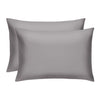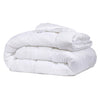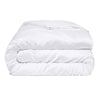The Daily Miracle
Percale vs. Sateen: Which Is Better?
Published
August 06, 2021
Author
Nicholas Crusie

There are only a few reasons you may have stumbled upon this post:
- You’re shopping for new sheets.
- You got stumped at a trivia night and are now curious.
- You fell down an internet rabbit trail and ended up here.
We’re going to go ahead and guess that number one is the closest to the truth. You’re trying to decide on a new pair of sheets, and in doing your research, you came across the words percale and sateen.
Now, you want to know what in the world they are and which one will make a better set of sheets for you. You’re in the right place! We’ll break down the differences for you and help set you on the right path.
What Is Percale?
Both percale and sateen are types of weave used to produce sheets, towels, etc… Percale uses a “one over, one under” weave to produce a strong fabric. This method takes a warp thread, puts it under a weft thread, then under another warp thread, and so on.
Percale sheets typically use a higher thread count and are very breathable. Now that you know what percale is, let’s get into the pros and cons.
Percale Pros
- If you get sweaty while you sleep, these are a good choice for you
- They won’t snag easily
- Gets softer with use
- Easy to wash and take care of
Percale Cons
- Not as soft and silky as sateen
- Doesn’t provide a lot of warmth
- Wrinkles easily
What Is Sateen?
If you think that sateen sounds a whole lot like satin, you’re correct. Plus, sheets made with a sateen weave do tend to come out silkier and satin-like. Where percale uses “one over, one under,” sateen weave uses multiple threads at one time. So many warp threads go over one weft thread, and so on.
Sateen sheets are typically made with cotton, lyocell, rayon, and polyester. The difference between sateen and satin sheets is the type of material used. Satin sheets use silk with a similar weave pattern. Let’s check out the pros and cons of sateen sheets.
Sateen Pros
- Wrinkle resistant
- Feels silky to the touch
- Looks shiny
Sateen Cons
- Less durable
- Pulls/snags easier
- Not ideal for sweaty sleepers
Which Is Better?
The great thing about the percale vs. sateen debate is this: you can win with either one. It truly is up to your personal preference. As you read through the pros and cons above, you may have noticed a few things that stuck out to you personally.
For example, if you’re a sweaty sleeper, you know already that percale sheets would be the better option. Here are a few other categories that might help you make up your mind, along with which type of sheet comes out on top.
Affordability
It’s not too difficult to find a wide variety of sheet prices, but percale sheets tend to have a lower price point. Each type of sheet has an average price of about $50, but you can also buy extremely high-end sets for upwards of $500.
Before you panic about spending a lot of money on sheets, consider this: you will spend about a third of your life in bed. With that in mind, don’t you deserve to treat yourself a little bit to be comfortable?
Durability
As seen in the pros and cons list above, percale sheets come out on top here. Sateen sheets are oh-so-comfortable, but the looser weave leaves them more susceptible to pulls.
Comfort
Both sheet types are extremely comfortable, so this one may be based on personal preference. However, many people consider a silkier pair of sheets to be more comfortable, so we’re calling sateen the winner in this category.
Sheet Maintenance
Percale and sateen sheets can both be machine washed, which is great news for all! They can both be put in the dryer as well, although percale tends to wrinkle more easily, so you may want to line dry or iron to keep them looking their best. Sateen sheets can be dried without the worry of wrinkles, so they come out on top here.
What Else Should You Consider When Choosing Sheets?
By this point, you may feel pretty confident about which type of sheet will be the best for you. But is there anything else you should consider when it comes to shopping for sheets? We have a few more thoughts.
How Often Should You Wash Your Sheets?
Washing sheets can feel like such a drag, but it’s very important to keep your sheets clean! Average sheets should be washed at least once a week. If that doesn’t sound like something you want to deal with on a weekly basis, consider our Miracle Sheets. The silver in our sheets is specially designed to keep you clean and safe as its antibacterial properties do not rub off on human skin.
Are Your Sheets Good for Your Skin?
Think of all the sweat, oils, and dead skin from your face and body that sheds onto your sheets each night. Each of those things presses up against your skin as you sleep or lie in bed.
Washing your sheets often can help mitigate negative impacts, but that might not be enough. Our sheets help to fight unwanted dust mites, germs, and bacteria which can cause skin issues and breakouts.
How Do Your Sheets Smell?
Do your sheets tend to smell musty and gross? Does your body odor sink into them and leave a lingering stink? Our sheets contain silver nanoparticles, which prevent the growth of odor-causing bacteria. This will help them stay fresh longer between washes.
The Miracle Sheet Difference
We’ve already mentioned a few of the great differences between our miracle sheets and your typical pair of bedsheets. If you’re ready to upgrade your bedroom and invest in a better night’s sleep, it’s time to see what else you can expect from our two different types of miracle sheets. We offer a sateen and a percale option, so now that you’re a pro at knowing the difference, choosing should be a breeze.
Signature Miracle Sheets
Our percale option is our signature Miracle Sheet set. Made from premium percale cotton, these sheets are super durable, breathable, and feel extra cool. They have a 350 thread count and an affordable price.
They are available in the following sizes:
- Twin
- Full
- Queen
- King
- Cali King
Infused with natural silver, miracle sheets are naturally thermoregulating and prevent up to 99.9% of bacterial growth.
Extra-Luxe Miracle Sheets
Our extra-luxe Miracle Sheets are the sateen option for those who would rather have a silky-smooth pair of sheets. Made with USA-grown Supima cotton, these sheets have a 500-thread count. Treat yourself to an ultra-silky, extravagant feeling pair of sheets!
Find these sheets in the same sizes as above and in the following color options:
- White
- Stone
- Sky Blue
Caring for Your Sheets
With proper care, your sheets will last you a long time. We do have some recommendations on how to best take care of your miracle sheets.
- Machine wash using warm water. Use mild liquid detergent.
- Tumble dry low. Don’t leave your sheets sitting in the dryer after the cycle is over to help avoid wrinkles.
- Iron on warm to remove wrinkles if needed.
- Cut any loose threads with scissors. Do not pull them.
- Avoid fabric softeners, powdered detergents, and personal care products that include benzoyl peroxide, alpha-hydroxy acids, and chlorine bleach.
To remove sweat stains, follow these instructions:
- Pre-treat the stain
- Soak the laundry that is stained in a detergent solution for one to two hours at room temperature. You can also rub it directly on the stained area to cover it and spread it over the stain with your fingers.
- Leave the detergent on the stained area. Then add the fabrics into the washing machine.
- Wash in a washing machine
- Run a washing cycle with a high dosage of the washing detergent at the highest temperature recommended by the care label.
- Rinse very well.
Covering It All Up
We think we’ve “covered” everything you need to know about the difference between percale and sateen bed sheets at this point! Ultimately, they are both great options; it just comes down to personal preference.
Percale sheets are crisp and breathable; sateen sheets are silky and luxurious. The best way to make a decision is to try them both out (we do offer a 30-day risk-free trial, after all).


















